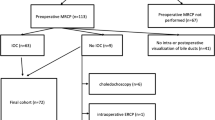Abstract
Purpose
Given evolving imaging technologies, we noted significant variation in the diagnostic evaluation of pediatric choledochal cysts (CDC). To streamline the diagnostic approach to CDC, and minimize associated expenses, we compared typing accuracy and costs of ultrasound (US), intraoperative cholangiography (IOC), and magnetic resonance cholangiopancreatography (MRCP).
Methods
Records of 30 consecutive pediatric CDC patients were reviewed. Blinded to all clinical data, two pediatric radiologists reviewed all US, MRCPs, and IOCs to type CDCs according to the Todani classification. When compared with pathologic findings, the concordance between and accuracy of each diagnostic test were determined. Inflation-adjusted procedure charges and collections for imaging modalities were analyzed.
Results
Mean typing accuracy overlapped for US, IOC, and MRCP. Inter-rater reliability was 87 % for US (κ = 0.77), 80 % for IOC (κ = 0.62), and 60 % for MRCP (κ = 0.37). MRCP procedure charges ($1204.69) and collections ($420.85) exceeded IOC and US combined ($264.80 charges, p = 0.0002; $93.40 collections, p = 0.0021).
Conclusion
Our data support the use of US alone in the diagnosis of pediatric CDC when no intrahepatic biliary ductal dilatation is visualized. However, when dilated intrahepatic ducts are encountered on US, MRCP should be utilized to distinguish a type I from a type IV CDC, which may alter the operative approach.



Similar content being viewed by others
References
Babbitt DP, Starshak RJ, Clemett AR (1973) Choledochal cyst: a concept of etiology. Am J Roentgenol Radium Ther Nucl Med 119(1):57–62
Ito T, Ando H, Nagaya M, Sugito T (1984) Congenital dilatation of the common bile duct in children. The etiologic significance of the narrow segment distal to the dilated common bile duct. Z Kinderchir 39(1):40–45. doi:10.1055/s-2008-1044167
Todani T, Watanabe Y, Narusue M, Tabuchi K, Okajima K (1977) Congenital bile duct cysts: classification, operative procedures, and review of thirty-seven cases including cancer arising from choledochal cyst. Am J Surg 134(2):263–269 (pii:0002-9610(77)90359-2)
Edil BH, Olino K, Cameron JL (2009) The current management of choledochal cysts. Adv Surg 43:221–232
O’Neill JA Jr (2006) Choledochal cyst. In: Grosfeld JL, O’Neill JA Jr, Fonkalsrud EW, Coran AG (eds) Pediatric surgery, vol 2, 6th edn. Mosby/Elsevier, Philadelphia, pp 2 v (xxix, 2146 p)
Schaefer JF, Kirschner HJ, Lichy M, Schlemmer HP, Schick F, Claussen CD, Fuchs J (2006) Highly resolved free-breathing magnetic resonance cholangiopancreatography in the diagnostic workup of pancreaticobiliary diseases in infants and young children—initial experiences. J Pediatr Surg 41(10):1645–1651. doi:10.1016/j.jpedsurg.2006.05.052
Shaffer E (2006) Can MRCP replace ERCP in the diagnosis of congenital bile-duct cysts? Nat Clin Pract Gastroenterol Hepatol 3(2):76–77. doi:10.1038/ncpgasthep0410
Tipnis NA, Werlin SL (2007) The use of magnetic resonance cholangiopancreatography in children. Curr Gastroenterol Rep 9(3):225–229
Suzuki M, Shimizu T, Kudo T, Suzuki R, Ohtsuka Y, Yamashiro Y, Shimotakahara A, Yamataka A (2006) Usefulness of nonbreath-hold 1-shot magnetic resonance cholangiopancreatography for the evaluation of choledochal cyst in children. J Pediatr Gastroenterol Nutr 42(5):539–544. doi:10.1097/01.mpg.0000221894.44124.8e
Vegting IL, Tabbers MM, Taminiau JA, Aronson DC, Benninga MA, Rauws EA (2009) Is endoscopic retrograde cholangiopancreatography valuable and safe in children of all ages? J Pediatr Gastroenterol Nutr 48(1):66–71. doi:10.1097/MPG.0b013e31817a24cf
Haliloglu M, Akata D, Gurel S, Ozmen MN, Akhan O (2003) Choledochal cysts in children: evaluation with three-dimensional sonography. J Clin Ultrasound 31(9):478–480. doi:10.1002/jcu.10206
Saito T, Hishiki T, Terui K, Sato Y, Mitsunaga T, Terui E, Nakata M, Takenouchi A, Matsuura G, Yahata E, Ohno S, Sato H, Yanagawa N, Masuda Y, Yoshida H (2011) Use of preoperative, 3-dimensional magnetic resonance cholangiopancreatography in pediatric choledochal cysts. Surgery 149(4):569–575. doi:10.1016/j.surg.2010.11.004
Halfhill TR (2011) Tom’s inflation calculator v 7.5.2. http://www.halfhill.com/inflation.html
O’Neill JA Jr (1992) Choledochal cyst. Curr Probl Surg 29(6):361–410
Lilly JR, Stellin GP, Karrer FM (1985) Forme fruste choledochal cyst. J Pediatr Surg 20(4):449–451 (pii:S0022346885000975)
Shimotakahara A, Yamataka A, Kobayashi H, Okada Y, Yanai T, Lane GJ, Miyano T (2003) Forme fruste choledochal cyst: long-term follow-up with special reference to surgical technique. J Pediatr Surg 38(12):1833–1836 (pii:S0022346803006249)
Benhidjeb T, Chaoui R, Kalache K, Mau H, Muller JM (1996) Prenatal diagnosis of a choledochal cyst: a case report and review of the literature. Am J Perinatol 13(4):207–210. doi:10.1055/s-2007-994365
Liu YP, Shih SL (2006) Prenatal diagnosis of choledochal cyst by magnetic resonance cholangiography. Pediatr Radiol 36(10):1112. doi:10.1007/s00247-006-0247-6
Rozel C, Garel L, Rypens F, Viremouneix L, Lapierre C, Decarie JC, Dubois J (2011) Imaging of biliary disorders in children. Pediatr Radiol 41(2):208–220. doi:10.1007/s00247-010-1829-x
Acknowledgments
The authors would like to acknowledge Cathey Carney for her assistance in identifying the study cohort and compiling cost data for this project.
Ethical standards statement
This study was considered to pose minimal risk to participants and was therefore considered an exempted study in terms of human subject research and informed consent by the Vanderbilt University Medical Center Institutional Review Board (IRB# 110122). It has therefore been conducted in accordance with the ethical standards laid down in the 1964 Declaration of Helsinki.
Conflict of interest
The authors declare that they have no conflicts of interest.
Author information
Authors and Affiliations
Corresponding author
Rights and permissions
About this article
Cite this article
Murphy, A.J., Axt, J.R., Crapp, S.J. et al. Concordance of imaging modalities and cost minimization in the diagnosis of pediatric choledochal cysts. Pediatr Surg Int 28, 615–621 (2012). https://doi.org/10.1007/s00383-012-3089-3
Accepted:
Published:
Issue Date:
DOI: https://doi.org/10.1007/s00383-012-3089-3




